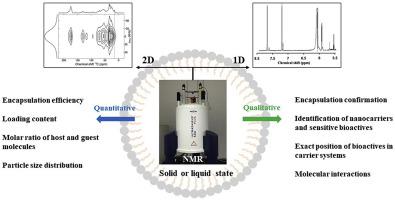Trends in Food Science & Technology ( IF 15.1 ) Pub Date : 2020-05-22 , DOI: 10.1016/j.tifs.2020.05.010 Roya Koshani , Seid Mahdi Jafari , Theo G.M. van de Ven

|
Background
NMR spectroscopy is based on measuring the intensity of electromagnetic radiation, absorbed by active atomic nuclei, in the radiofrequency region. It is considered as a powerful analytical tool for examining e.g. the molecular structures of edible matrices used in the food industry. This technique attracts wide attention due to the quantitative determination of the molecular species. Principally, the applied external electromagnetic field leads to the changes in the resonance frequency of the nuclei which appears as a spectrum. The isotopic forms of 1H and 13C are the commonly considered nuclei in the analysis of food ingredients. Other isotopes including 15N, 17O, 19F and 31P are less frequently assessed.
Scope and approach
One- and two-dimensional NMR spectroscopies along with imaging are able to deliver a large amount of information on the molecular structure, loading content, encapsulation efficiency, optimum formulations, stoichiometry, structural sensitivity in different conditions, molecular interactions and the dynamics of molecular motions, as well as release properties of ingredients involved in nanoencapsulation systems. Specific emphasis of this study has been placed on diverse applications of one and two-dimensional NMR methods in the characterization of nanoencapsulated food constituents.
Key findings and conclusions
NMR spectroscopy is nondestructive, noninvasive, highly reproducible, applicable to any type of sample (solid/liquid/semi-solid) and provides a selective analysis methodology for functional groups. As a superlative technique, it can be used for characterizing sensitive nanoencapsulated bioactive agents and their corresponding carriers in different environments without a need for physical separation of ingredients and/or specific treatments.
中文翻译:

通过核磁共振(NMR)光谱深入生物活性负载的纳米载体
背景
NMR光谱基于测量射频区域中被活性原子核吸收的电磁辐射的强度。它被认为是一种强大的分析工具,可用于检查例如食品工业中可食用基质的分子结构。由于对分子种类的定量测定,该技术引起了广泛的关注。原则上,施加的外部电磁场导致原子核共振频率的变化,该频率以频谱的形式出现。1 H和13 C的同位素形式是食品成分分析中通常认为的核。其他同位素,包括15 N,17 O,19 F和31P的评估频率较低。
范围和方法
一维和二维NMR光谱学以及成像技术能够提供有关分子结构,负载量,包封效率,最佳配方,化学计量,不同条件下的结构敏感性,分子相互作用和分子运动动力学的大量信息以及纳米封装系统中涉及的成分的释放特性。这项研究的特别重点放在了一维和二维NMR方法在表征纳米胶囊食品成分中的各种应用上。
主要发现和结论
NMR光谱法是无损,无创,可重现的,适用于任何类型的样品(固体/液体/半固体),并为官能团提供了选择性的分析方法。作为最高级的技术,它可用于表征不同环境中敏感的纳米囊封生物活性剂及其相应的载体,而无需成分的物理分离和/或特定处理。











































 京公网安备 11010802027423号
京公网安备 11010802027423号